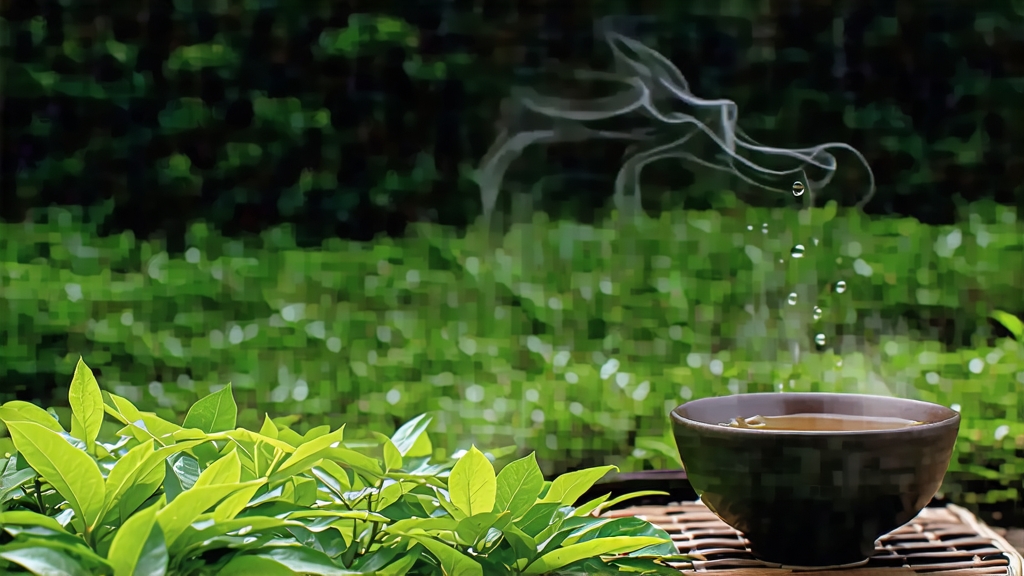
Cradled in the cloud-veiled peaks of Taiwan’s Chiayi County, Alishan High-Mountain Oolong (阿里山高山烏龍) is the island’s most fragrant ambassador of the semifermented art. Rising between 1,000 and 1,400 m above the tropical sea, the Alishan range traps moist Pacific fog in ancient cedar forests; that same fog slows leaf growth, thickens cell walls, and concentrates the sweet aromatics that have seduced tea traders since the late 1800s.
History
Oolong technology migrated from Fujian’s Wuyi Mountains to northern Taiwan during the Qing dynasty, but it was the 1980s economic shift that sent farmers upslope. Searching for cooler climates to mimic the rock-ribbed minerality of Wuyi, planters discovered that Alishan’s red laterite soil, diurnal swings of 10 °C, and year-round mist created a softer, milk-sweet style. By 1986 the government certified “Alishan High-Mountain Tea” as a geographical indication, and within a decade these jade-green ribbons overtook Dong Ding in domestic auctions. Today the region hosts over 3,000 smallholder gardens, many no larger than two hectares, stitched into terraced hillsides that disappear into cedar clouds.
Cultivars
The dominant cultivar is Qing Xin (青心烏龍 “Green Heart”), a slow-budding, insect-susceptible strain prized for its lilac nose and lingering rock-sugar finish. A minority of plots grow Jin Xuan (金萱 “Milk Oolong”), engineered in 1981 to yield a natural lactone creaminess, but purists argue that only Qing Xin can translate Alishan’s terroir into the signature “high-mountain qi” (高山氣)––a cool, sparkling sensation that drifts down the throat like mountain breeze.
Harvest Calendar
Spring plucking begins between late March and mid-April, when three leaves and a bud swell with winter starch. The shorter autumn season (early October) produces a lighter, more floral cup; many growers skip summer to let the plants rest, a luxury permitted by the premium price their spring pick commands. Experienced pickers work from dawn to 10 a.m. while dew still glistens; afternoon sun would oxidize the edges prematurely, flattening aroma.
Crafting the Leaf
Alishan Oolong is a “light-oxidation, heavy-balling” style, hovering at 15–25 % oxidation—halfway between green tea and traditional Dong Ding. The choreography unfolds over 36 hours:
- Solar Withering: Leaves are spread 3 cm thick on bamboo trays under filtered morning sun for 20–30 min to reduce moisture to 70 %.
- Indoor Withering: Tray stacks move indoors for 6–8 h of tumbling every hour; bruising edges initiate oxidation while the leaf core stays green.
- Oxidation Pause: A 90 min rest in 22 °C, 75 % RH rooms lets floral lactones form; masters sniff every 15 min, chasing a scent shift from cut grass to white peach.
- Pan-Kill: A 280 °C drum roast for 3 min halts oxidation, locking in jade color.
- Rolling & Balling: Cloth-wrapped leaves are spiral-pressed in mechanical rollers, then unpacked, reheated, and rewrapped up to 30 cycles; the orbit-like motion compresses cells into tight hemispheres that will unfurl like miniature fireworks in the cup.
- Drying & Sorting: A 90 °C conveyor bake reduces moisture to 3 %; stems and yellow flakes are winnowed out by hand.
- Roasting (optional): Competition lots receive a gentle 70 °C charcoal finish over longan wood for 6–10 h, adding chestnut depth without masking alpine florals.
Terroir in a Teacup
Chemical analysis reveals why Alishan tastes like sipping orchids in a pine forest. High elevation boosts L-theanine (umami sweetness) and monoterpene alcohols (linalool, geraniol) while suppressing bitter catechins. The result is a liquor that is pale champagne-gold, almost luminescent, with a viscosity that coats the lips yet finishes crystal-clean. Notes oscillate between white gardenia, honeydew, and a cooling hint of eucalyptus that echoes the cedar